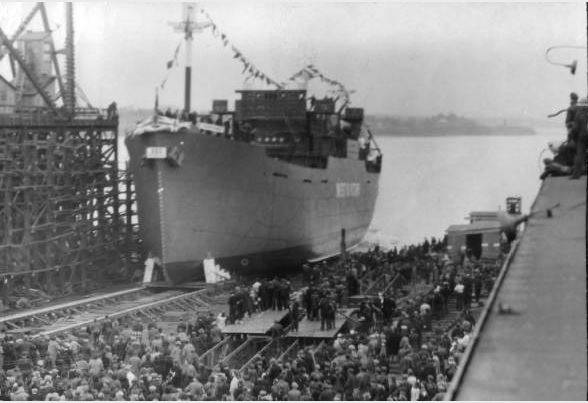Beam 46 ft 5 in (14.15 m) Propulsion Screw propellor | Depth 22 ft 9 in (6.93 m) Length 96 m | |
 | ||
Tonnage 2,878 GRT1,653 NRT10,000 DWT Installed power Triple expansion steam engine Crew 34, plus 4 DEMS gunners | ||
Park Ships were merchant steamships constructed for Canada’s Merchant Navy during the Second World War. Park ships and Fort ships (built in Canada for operation by the British) were the Canadian equivalent of the American Liberty Ships. All three shared a similar design by J.L. Thompson and Sons of Sunderland, England. The Jasper Park was first Park ship sank to enemy attack, she sank in the Indian Ocean after a torpedo attack.
Contents
Park Steamship Company
The Allied merchant fleet suffered significant losses in the early years of the Battle of the Atlantic as a result of U-boat attacks. The Park Steamship Company was created by the Canadian government on April 8, 1942 to oversee construction of a merchant fleet to help replace the lost vessels and to administer the movement of materiel. This was part of a coordinated Allied effort that saw the construction of British, American and Canadian merchant ships using a common class of vessel known as the North Sands class (named after a beach near the J. L Thompson yard on the River Wear).
Vessels
Over the next three years, the company ordered approximately 160 bulk cargo ships and 20 tankers that would all fly the Canadian flag. Ships at 10,000 tons deadweight were known as Park class. Smaller vessels, at a nominal 4,700 tons, were at first designated Grey class but were later called Park ships as well and were commonly known as the 4700 tonner Park ships. All the Park ships were powered by coal driven steam engines. All but two vessels launched were named for federal, provincial or municipal parks in Canada. Some were armed with bow guns and anti-torpedo nets. Two of the Park ships were lost to natural hazards and four were lost due to enemy action. One, Avondale Park, built at the Pictou Shipyard in Pictou, Nova Scotia was one of two Allied ships destroyed by enemy action in the North Sea in the last hour of the war in Europe on May 7, 1945.
At the same time, Canada produced 90 additional vessels for the American government which were turned over to the British Merchant Navy under a lend-lease agreement. Built to the same design but designed to burn oil instead of coal, these vessels were known as Fort ships, and they took their names from forts. Notable ships of this type included Fort Cataraqui, Fort Rosalie, and Fort Charlotte. Like many of the Fort ships, Fort Charlotte was launched as a Park.
Shipyards
The shipbuilding program was not easy to implement as Canada had only four operational shipyards with nine berths in 1940. By 1943, there were six additional shipyards and a total of 38 berths. These were all private shipyards located across Canada - on the East Coast at Pictou and Saint John, in Montreal, Sorel and Lauzon on the St. Lawrence River, at Collingwood on Georgian Bay, and Victoria, Vancouver and Prince Rupert on the Pacific Coast. Only the yards at Montreal, Saint John, Victoria and Collingwood had existed before the war. By 1945, there were 57,000 men and women employed in building or repairing merchant ships in Canada and several thousand more were employed building ships for the Royal Canadian Navy.
The table shows the name of the shipyard and city, and the number of vessels launched by each yard. Eventually thousands of Canadians would serve aboard these Canadian Merchant Navy ships.
Lost in action
Jasper Park was the first Park ship lost to enemy action. The Point Pleasant Park was torpedoed near Cape Town, South Africa on February 23, 1945 with nine crew lost. The Tabor Park sank in the North Sea on March 13, 1945 after U-boat attack. The Avondale Park sank with her British crew on May 7, 1945.
